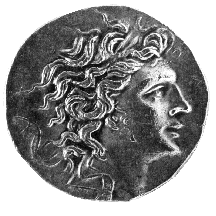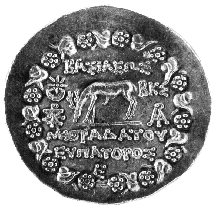



(47) Pontos, Mithradates VI the Great Eupator - AR tetradrachm,
75 B.C., 16.78 g. (inv. 91.078).
Obverse: Diademed head of Mithradates r.
Reverse: In ivy wreath, grazing stag l.; in l. field, star
and crescent above monogram; in r. field, ![]() (date of the Bithynian Era = 75 B.C.) above monogram;
(date of the Bithynian Era = 75 B.C.) above monogram; ![]()
![]()
![]() : of King Mithradates Eupator.
: of King Mithradates Eupator.
Provenance: Edward Gans, 1959.
Bibliography: M.J. Price, "Mithradates VI Eupator,
Dionysus, and the Coinages of the
Black Sea," Numismatic Chronicle, 7th series, 8 (1968) 1-12.
Mithradates was a bitter enemy of Rome, with whom he fought three wars between
88 and 63 B.C. He saw himself as the protector of the Greeks, who initially
welcomed his attempts to stave off the Romans, but in the end his rule was
oppressive, and he met resistance even in his own territory. At the height
of his power he controlled much of Asia Minor and Greece, choosing Pergamon
as his capital and royal residence. Rome eventually forced him to give up
his conquered territory, pay a huge indemnity, and retreat to his original
borders. He committed suicide in 63 B.C.
Since most of Mithradates' coins are dated, the origin of the types on this
tetradrachm can be traced to 89/88 B.C., the year of his great invasion
of Asia Minor. The clearly idealized portrait of Mithradates on the obverse
makes a sharp break with the hard-bitten, realistic style of his predeces
sors' portraits (see no. 46). In contrast to their
foreign features, short beards, and long sideburns, Mithradates, over fifty
at the time, appears youthful, clean-shaven, and Hellenized, with the flowing
hair and upward gaze associated above all with portraits of Alexander the
Great (see no. 45). The portrait type was probably intended to appeal to
the Greeks of Asia Minor, to whom he wanted to appear as their saviour,
the new Alexander.
The stag on the reverse, an attribute of the Greek goddess Artemis, may
have been intended to refer to her major cult and sanctuary in Ephesos in
Asia Minor and thus again to appeal to the Greeks of the area. The star
and crescent, perhaps a family device, represent the sun and moon and allude
to the Persian worship of celestial bodies. The ivy wreath refers to Dionysos,
Mithradates' patron deity, a Greek god but one associated with the East.
K.J.B.



All contents copyright (c) 1996.
Lawrence University
All rights reserved.